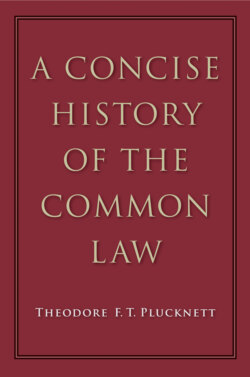Читать книгу A Concise History of the Common Law - Theodore F. T. Plucknett - Страница 81
На сайте Литреса книга снята с продажи.
THE VILL OR TOWNSHIP
ОглавлениеBeginning at the very bottom of the scale, the lowest institution we find is the vill or township.1 It is moreover the most complicated and obscure. Its history was possibly different in different parts of the country and is extremely difficult to disentangle from that of certain other institutions—the ecclesiastical unit of the parish, the social unit of the village, and the economic unit of the manor, which are all the subject of learned controversy. It would seem as if the typical vill (if one can use the term of an institution which varied so greatly) would have looked something like this. There will be a little group of houses, sometimes in a cluster, and sometimes ranged along an ancient road. Nearby there will be the parish church, and in many cases there will be the hall or mansion of the lord of the manor, if it so happens that the vill coincides with a manor, which may or may not be the case; sometimes a manor consists of several vills; on the other hand, a vill may contain several manors. Surrounding it there will be two, or more usually three, large fields. Each of these fields will be divided into a large number of long, narrow strips of about half an acre each, and every household in the village will own a greater or less number of these strips scattered irregularly through the fields. This system of scattered strips is very ancient and lasted long after the middle ages. It has been suggested that the method was imported by the Anglo-Saxons and was not native to England. The prehistoric field seems to have been a small irregular plot; the Celtic field which replaced it in England was apt to be oblong owing to the necessities of ploughing. It seems also to have been a peculiarity of Celtic agriculture to prefer hills or elevated ground, while the Saxons introduced valley settlements. The Saxons, moreover, were accustomed to use the large team of eight1 oxen to draw their ploughs; this, of course, gave more power, but made turning more cumbersome. Consequently it became necessary to plough a much longer furrow in order to secure the advantage of the larger team, and hence the long narrow strips—but why they were scattered, has long been debated. It was never easy to believe that an egalitarian dogma was applied regardless of efficiency and convenience; more probably, those who co-operated in each day’s ploughing took a share each, as the work proceeded from day to day.2 It is not uncommon for fields in England at the present day still to bear traces of these arrangements; on the hillside Celtic divisions may still be found represented by the banks caused by constantly ploughing the same plot, while lower in the valleys the long, narrow strips of the mediaeval field may be discerned. Photographs from an aeroplane are particularly useful in revealing these features.3
